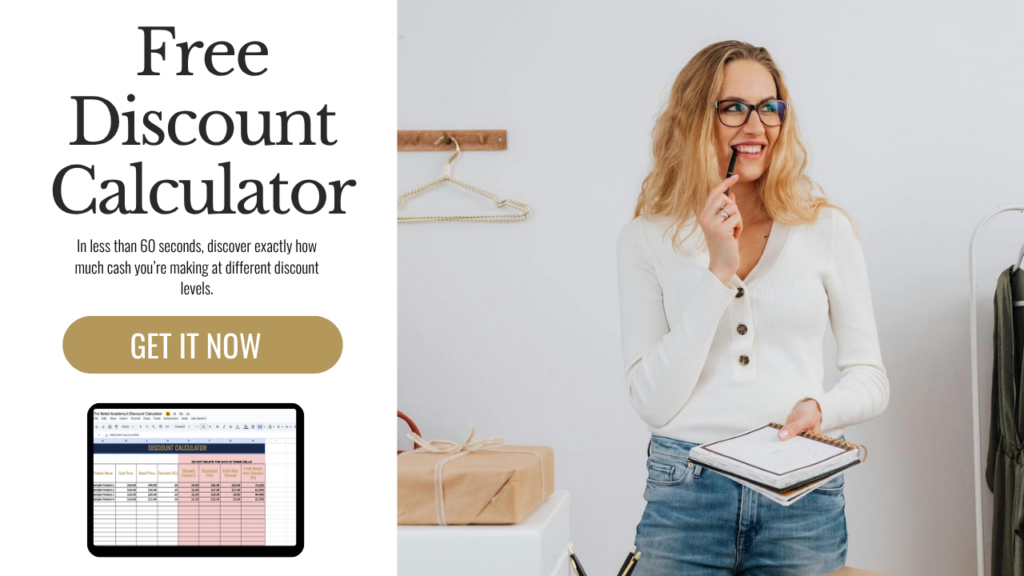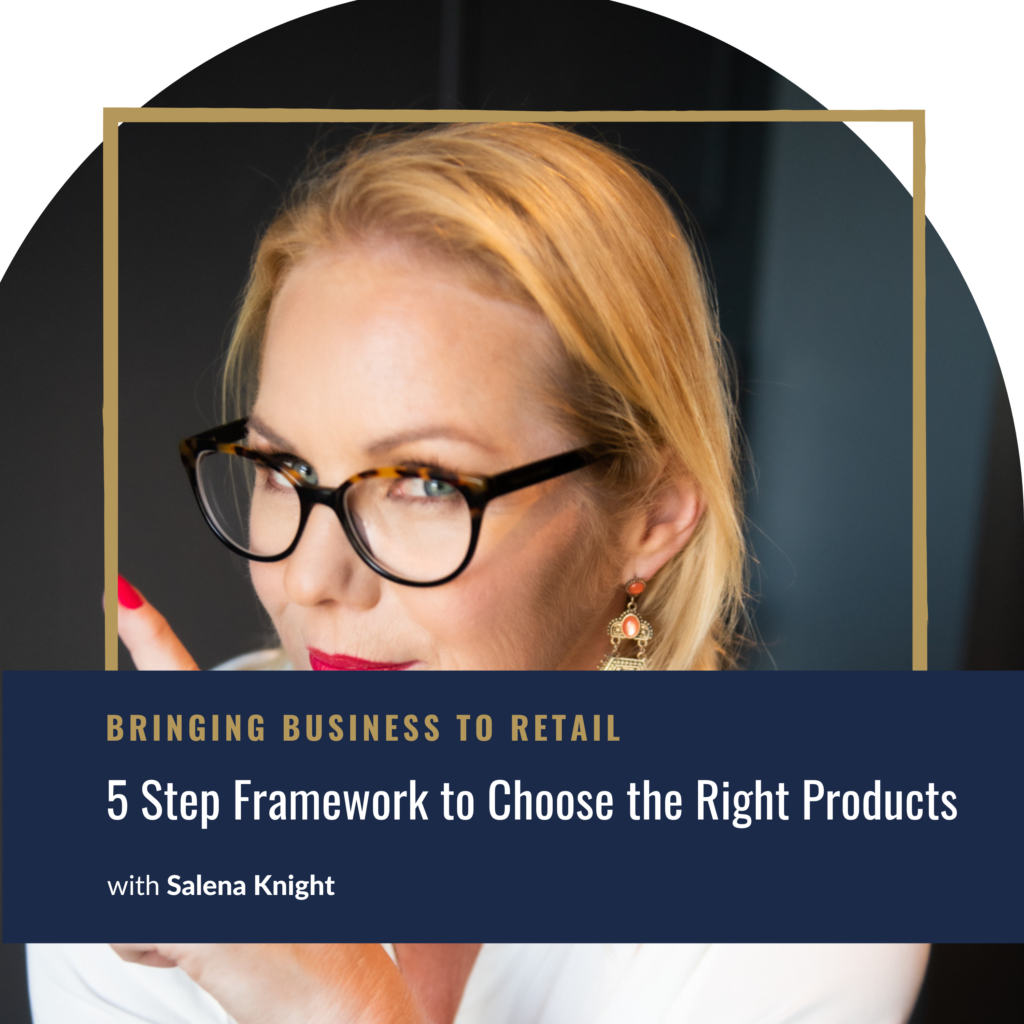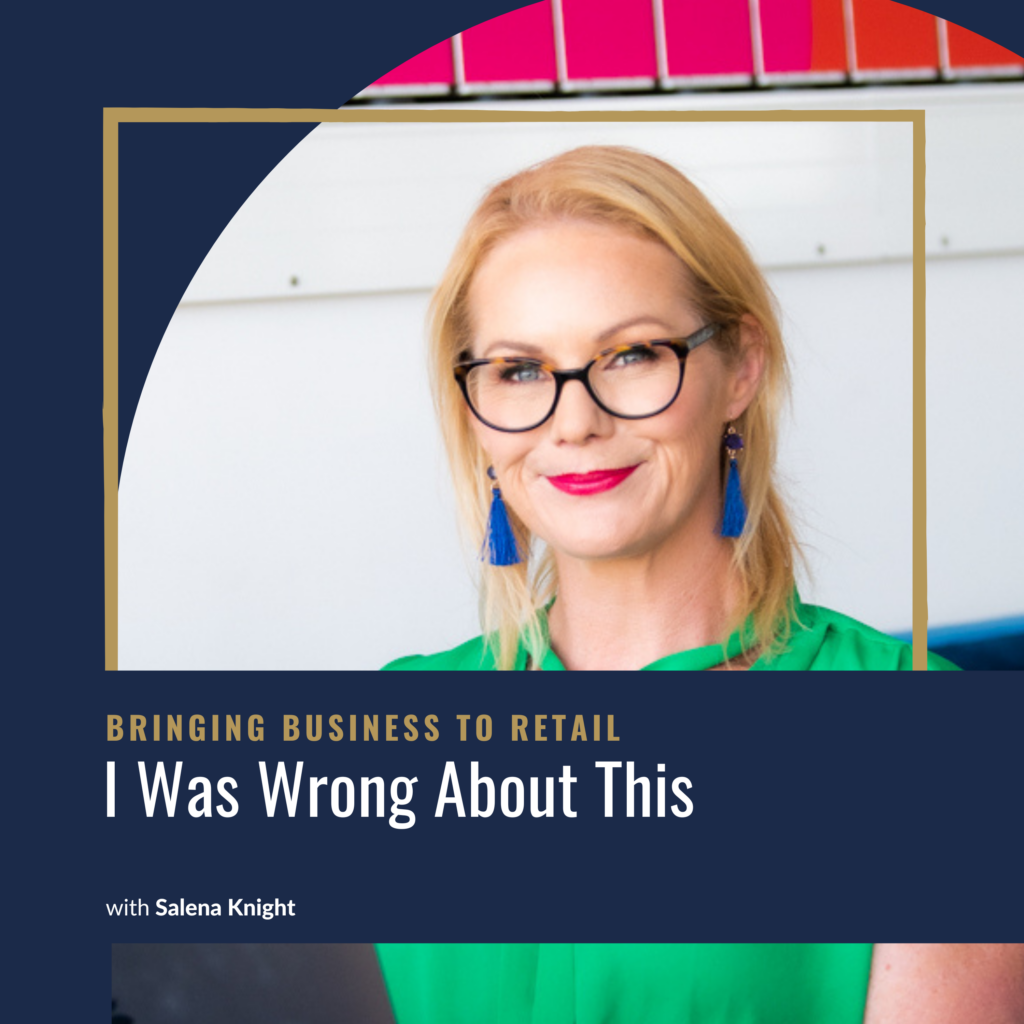
SHOW NOTES
Black Friday and Cyber Monday can make or break your year, but if your only strategy is discounting, you’re probably leaving profit on the table.
In this episode of Bringing Business to Retail, I break down how to build a profitable Black Friday campaign that doesn’t destroy your margins or your brand.
You’ll learn why competing on price is a losing game, how to identify when discounts actually make sense, and the simple math you need to know before you ever hit “publish” on that sale.
I share practical steps to segment your customers into four key groups, new, one-time, repeat, and VIP buyers, and how to create offers that fit each group.
Instead of deep discounts, I will show you smarter ways to add value: think bundles, gifts with purchase, loyalty point multipliers, early access, or exclusive experiences.
You’ll also hear how to flip the script with an anti–Black Friday campaign that aligns with your brand values and builds long-term trust, not short-term chaos.
This is the episode that helps you protect your profit, plan strategically, and walk into the new year with more cash in the bank, not less.
🎧 Listen now and grab the free Discount Calculator to plan your next promotion
LISTEN NOW on The Bringing Business To Retail Podcast
Alrighty. Let's talk about the elephant in the room when it comes to Black Friday and Cyber Monday. Yes, my friends, discounting, everyone does it. Your competitors do it. The big box stores do it. Even brands that never discount all of a sudden seem to roll out 40%, like it's nothing. And you might be there thinking, well, if I don't discount, am I even going to make sales?
Can I even compete? Here is what I know. There is a time and a place for discounting, but if you are competing on price alone during Black Friday, you might have already lost because there will always be someone who is willing to go lower than you always, and when you slash your prices to keep up, you might get the sale, but you are also training your customers to never pay full price again.
And worse than that, you are cutting your margins and you may not be able to even afford to lose that money. Now you might be thinking, well, Sal, everyone expects a discount. It's Black Friday. That's what Black Friday was built for. And I hear you. You know, if you've been listening to the podcast for a while, I'm the bargain hunter.
I love me a good discount. But if you don't want to discount. What I'm going to show you is how to win Black Friday without giving away the farm. Welcome back to the Bringing Business to Retail Show where we talk all about strategies and solutions to make you more money in your retail or e-commerce business.
Let's dive in. Okay, first things first. Let's talk about why discounting is such a trap. When you discount, especially those deep discounts, 20%, 30%, 40% off. You're not just reducing your revenue. You are squeezing your margins so tight that in a lot of cases you're probably barely breaking even. Maybe you're not even covering your costs.
Once you factor in picking, packing, shipping, or if you've got a bricks and mortar store, rent payment processing, and of course the time to serve the customer. I once audited a sports nutrition company and they had reps who used to go and take their products into all different types of retailers. The reps would go with a whole basket of products and say, you know, Hey, you are a bike store.
Your customers might like this. And then they would sell that product to the store. But the thing was, it wasn't an eight hour a day role, and these people were full-time. And so what the business owner would do is when the reps weren't out on the road selling, she would use those people to pack all of the orders.
Now, once we did a costing of the time to pick, pack, and ship. It was actually three times more than if the product would've been sitting in a fulfillment house and fulfilled by a third party logistics company, or a three pl, three times more. That is mind boggling. Now, I see this every year. Store owners get caught up in Black Friday hype.
They panic because they see that competitors are going really hard with discounts. You only have to go to your local mall and everything is 50, 60, 70% off. So it's easy to think, well, I've got to match that, or I just won't get the customers. They'll go elsewhere. And so what ends up happening is they drop their prices and sure they might get sales, but when January rolls around and they look in their bank account, they realize that they have worked their butts off during the holiday season for almost nothing.
And here's the kicker. You have taught your brand new customers. To wait for a sale to not pay full price. So why would they buy from you again in January or February at full price when they've already thought that this is not worth full price? Before I jump in any further, let me be very, very clear here.
I am not saying don't discount at all. I firmly believe that discounts to clear stock that is past its viability in your business is a very effective and very smart business decision. What I am saying is that discounting cannot be your only play if you are going to discount. You need to be strategic about it.
You need to know who you are discounting to. What you are discounting, and most importantly, why are you discounting these products? And that means knowing ahead of time before you go into a promotion, whether you are going to be eating your margin. Is this a loss leader? Are you being strategic? Are you understanding that selling a product at a price where you don't make money is okay because you have made a decision, you have reached a point, you are literally liquidating for cash alone.
Knowing that the customers that you bring in with deep discounts may not stick around, so your customer lifetime value may not ever be more than that first purchase, especially if you have not got a customer journey mapped out to turn those people into repeat customers. Which means you cannot afford to pay a high CAC customer acquisition cost.
You can't be spending a lot of money to bring those people in if they're actually gonna cost you money to buy. And this is where data becomes your best friend. 'cause here's the truth, black Friday isn't just about moving product. It is about acquiring the right customers. Keeping your best customers engaged and setting yourself up strong for the year ahead.
This is the busiest time of the year for most of you. You are going to make the most of your revenue in Q4, and so you have to make sure that you are setting yourself up for 2026 for the next year, and you can do all of that without racing to the bottom on price. So. Let me talk about how I think you can do that.
First of all, I think it's really, really important that you segment your customers because not all customers are created equal. You have got brand new people who have never bought from you. You have one-time buyers. You've got the people who are intermittent buyers. They buy every now and then, and then there's your VIPs, the customers who will come back again and again.
They are telling everybody about you and they're basically keeping your lights on. If you are sending the same Black Friday offer to everyone, I can almost guarantee that you are probably leaving money on the table. Here's why. Think about your best customers. Your VIPs don't need a massive discount to buy from you.
That is not their motivator. They already love you. They're already going to shop with you. So why are you going to try and offer them 30% off when they will happily pay full price? If maybe you threw in a little bit of a bonus, you are wasting a touch point if these people aren't even interested in discounted products.
You are literally just filling their feed with noise. Whether that is their eyeballs on social media, whether that is their eyeballs on email, whether that is there is if you are using some kind of campaign like reels. The fact is it is noise. Those repeat buyers, your loyalists, you need to give them something that makes them feel special without destroying your margin.
What does that look like? It could be early access to a product drop. It could be exclusive products. If you've got a really small, uh, limited edition, maybe you just offer it to those people. It could be a gift with purchase, it could be free shipping, it could be a bonus, loyalty points multiplier. If you've got a loyalty program running, it does not.
And for these people, I'm gonna go so far as to say it should not be a price cut. And I'm actually going to highlight here that I don't think that you should be discounting for these customers. One of the biggest oversights I see is businesses not segmenting their customer databases and not segmenting their email lists.
They just blast everyone with the same offer, and then they wonder why people aren't buying. I'm always up for giving you action steps. Here is your first action step. I want you to go into a customer database. I want to split your list or your, your email list or your customer database into. Three or four groups.
I would go with the new people who haven't purchased yet. I would go with the people who've purchased once, those one-time buyers, then I would go with the repeat customers. So the intermittent buyers, maybe they come back two or three times a year, and then you have your VIPs, the ones who are keeping the lights on.
They're going to be 20% of your customer base who probably bring in 80% of your revenue. And then here you go. I'm gonna ask you to build different offers for each group. I know I am asking a lot, but that alone will transform your Black Friday results if you are up for more. Can I move on to strategy number two?
And that is always, and you've heard me say this so many times, add value instead of cutting price. And this is where a lot of people get stuck because. Honestly, the whole industry has conditioned all of us, not just our customers, but even us, to think that Black Friday equals a discount. But here's what I've learned, and this is gold, my friends.
Smart brands are going way beyond price to create offers that feel valuable without eroding margin. Let me give you some examples. Instead of 20% off. What if you just bundled some products together? Buy this, get that, buy two, get the third free. You are increasing your average order value. You are moving more units, and it feels like a deal to the customer, but you are protecting your margin because the, any discount that you have is split across the board.
It's split across three products, and so you might have 30% off, but actually across three products, it's only 10%. I always love a good bundle. Especially in the holiday time. We are all good for things like gift baskets and gift sets, my friends, the holiday time. If you ever wondered if a bundle's gonna work for you, the holiday season is the opportunity that you have been looking for.
To test this gift with purchase are probably my favorite promotion. You can do this by saying if someone spends a certain amount, they get a gift with purchase. It could be a sample, it could be a smaller product, it could be something that you wanted to shift anyway. Customers love this because it feels exclusive and you are not discounting your hero products.
I would go so far as to say you should be working with your suppliers to create offers that are exclusive to your store and your customers. Another one that you can do, which I don't see this done often enough. Which is loyalty point multipliers. So if you have a loyalty program, you could offer double or triple points during Black Friday or four specific purchases.
Brands are using loyalty programs, not just as a retention tool, but as a way to differentiate during the peak sales periods. Because here's the thing, points don't cost you anything upfront. They're a future incentive to your customer. But to your customer, it feels like they're getting more. I mean, some customers never redeem points.
They're, they're the best. And if you really wanna get creative, look at experiential rewards. Maybe it's access to a private sale, a personal shopping session, a behind the scenes look at you, how your business runs. I know a brand that I've worked with used to run warehouse tours and I'm like, really, customers are interested in that?
Oh yes, my friend customers are interested in that. VIP treatment, all of this stuff can cost you almost nothing, but it builds massive brand loyalty. I guess what I'm trying to say is you've got options. Discounting isn't the only option. It's an easy option, but it's not always the smart option. Something that has come up inside of a Scalia store accelerator has been this concept of the anti-Black Friday campaign.
This one I feel is a little bit cheeky and honestly, many independent retailers seem to think that just by saying they're not doing Black Friday because they don't believe in discounting, then that's a campaign. But when you deliberately go against what everyone else is doing during Black Friday, and you are going to make that your positioning.
You need to run a campaign to tell people that, huh? But you thought that just saying you weren't doing Black Friday was the easy way out. It's not. If every other brand is out there with their 30, 40, 50% off and the biggest sale of the year, and you want to come out and say, we don't discount, or we are not participating in Black Friday, you have to tell people why.
But that's only step one. You then have to run that campaign and you have to run that campaign as hard as any other campaign that you might run, whether that is a discount or a gift with purchase. Saying that you are opting out isn't a campaign. It is literally just passing an opportunity by this to be able to do this well.
It takes guts and it takes commitment. It does not work for every brand. If you have built a brand around quality and craftsmanship or sustainability or exclusivity, this can be an option, but you need to leverage it. Some brands do this really well. They'll create a campaign during Black Friday that says something like, we're not participating in Black Friday because we believe in fair pricing all year round.
Instead, here's what we're doing. And then they might offer free shipping. Or quite often I see a donation to a cause with every purchase. Uh, sometimes it might even be like early access to a new product, but here's what I'm trying to get across. It is still a campaign. It is not just a discount. If you are going to opt out of Black Friday, you have to run that just as hard as if you are running any other type of campaign.
But customers who align with your values will love an anti-Black Friday campaign. It makes them feel good about buying from you, and it reinforces your brand positioning. And look for you, you are not tanking your margin. I don't think everybody should do this, but I think if you decide to take this option and if you feel icky about the whole discounting over consumption during Black Friday, it might be the play for you.
But the key is to own it. You can't just post once and say, we're not doing it. You cannot be half-hearted. If you are going to stand against discounting, then you have to lean all the way in and make it part of your story and you have to market it as much as you would any other product launch. Let's get tactical because I know some of you're thinking, Sal, this all sounds great, but if I don't discount, I will not hit my targets.
I've looked at the data. I know this. Okay. So let's talk about how we discount without killing your business. So we've gone through the strategies that you can use. Now we're going, okay, if you're going to go with discounts, there are some really key factors that you need to factor in to make sure that we are not just doing this to lose money, and we have to start by reverse engineering that Black Friday goal.
So what does that look like? You can't just pick a number out of thin air because it sounds good. Have to start with your profit goal or your revenue goal, or how many units you need to move, and then you need to work backwards. You need to figure out what discount you can actually afford to give. Let me give you an example.
Let's say that you want to make $50,000 in profit during the Black Friday weekend. You know that your average margin is 50%. So that means that you would need to spend, if you've got 50,000 in profit and you have a 50% margin, you need to sell a hundred thousand dollars in revenue to hit your profit goal.
Now, if you discount 30% across the board, your margin drops to 20%. So it was at 50, 30% discount. You're now down to 20. Suddenly you need to move way more revenue to hit that same profit number. You need to do $250,000 in sales to make the same $50,000 profit. Ooh, that hurts, right? Do you see how quickly this can get out of hand?
So instead, you reverse engineer it, you say, okay, looking at these numbers, I can afford to discount. 15% on particular products and still hit my profit target. If I increase my average order value, and maybe if I throw in a bundle that will get me to where I want to go, or I am only going to discount my kill products, the products that need to go, and I'm going to push my high margin hero products at full price with a gift with purchase.
The point is you have to be in control. You get to decide what this looks like for you, and when you start with your goal, whether that is your profit goal, whether that is units moved, whether that is revenue, and you work backwards, you make better decisions, you make smarter decisions because you are making them with an outcome in mind.
The lesson here is that you have tools to use beyond price, so you should use them. All righty. Let's bring this home. If you are listening to this and you're thinking, okay, Sal, I'm convinced, but what do I do next? Here is your action plan. First and foremost, go and look at your customer list, whether that is in your customer database, whether that's in your POS, whether that's in your email marketing.
Separate those people out. Who are the people who've never bought before? Who are the people who've bought once? Who are those repeat customers, and who are the VIPs? If you can, I would love for you to build out different offers for each group. If you don't have the resources for that, then start at step two where I'm about to go reverse engineer and figure out what you need to sell to hit your goals.
So what is that goal that you have? And then reverse engineer who you need to sell the product to and what that offer needs to be. Again, we have these four buckets of people. Are we going to just run something to our VIPs because we know that we can hit a specific number? Are we going to just do a discount to just the group of people who have only bought once to try and re-engage them to come back again?
We can start to stack these offers on top of each other to make sure that we hit our goals, so we're reverse engineering what we're going to sell and who we need to sell to to hit our targets. Then you can come and decide what you can afford to discount. And I mean, run the numbers my friends. Don't just guess reverse engineer your goals and figure out what works.
To help you do this, I have actually built you a discount calculator. You can get it for free if you head over to selena knight.com/calculator. I will give you a discount calculator where you can plug in these numbers and you can see what you can afford to discount. So step one, we segmented our list.
Step two, we reversed engineered and we figured out who we were going to sell to to hit our goals. Step three, then we start to look at the different types of offers. Are we gonna do a bundle? Are we gonna do a diff with purchase? Are we going to do the loyalty points or the early access? Are we gonna do discounting?
Think about value, not just about price cuts, and then step three B. I'm not gonna say step four, but this is like an addendum to step three. Think about whether an anti-Black Friday campaign aligns with your brand. You don't have to play the discount game if you don't want to, but know that you have to run that as a campaign, as a promotion.
And here is the important thing. Please, whatever you do, don't just copy what somebody else is doing. Your business is unique, your customers are unique, your brand is unique, and so your Black Friday strategy should be unique to you and your customers. Look, I get it, black Friday is overwhelming. The pressure to discount is very, very real, and it can feel like if you don't go big, you'll just get left behind.
But here's what I want you to remember. Winning Black Friday isn't about having the biggest discount. It is about making smart decisions that protect your margins, attract the right customers, and set you up for long-term success. Because what is the point of making a ton of sales if you can't pay your bills in January?
What is the point of bringing in new customers if they only ever buy from you once and only when you're on sale? And if they actually cost you money, you didn't start your business to work for free. You started it to build something sustainable and profitable and something that you're super proud of, and that means protecting your margin even during the busiest sales period of the year.
There you go. I would love it if you could go out there and build your Black Friday strategy segment your customers, add value, get creative, and don't be afraid to do something different, and I will be here cheering you on. If you found this podcast episode helpful, please do me a favor, share it with another store owner who is stressing about Black Friday.
Let's lift each other up. Remember, their customers are not your customers and their brand is not your brand. Let's lift each other up. That's all from me. I will see you on the next episode of the Bringing Business to Retail podcast. And if you would love that discount calculator, head over to selena knight.com/calculator and I will have it there.
You can grab it for free. Alrighty guys. Bye. So that's a wrap. I'd love to hear what insight you've gotten from this episode and how you're going to put it into action. If you're a social kind of person, follow me at the Selena Knight and make sure to leave a comment and let me know. And if this episode made you think a little bit differently or gave you some inspiration.
Or perhaps gave you the kick that you needed to take action, then please take a couple of minutes to leave me a review on your platform of choice, because the more reviews the show gets, the more independent retail and e-commerce stores just like yours, that we can help to scale. And when that happens, it's a win for you, a win for your community, and a win for your customers.
I'll see you on the next episode.
Share this episode
Watch The Video











